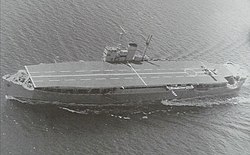Akitsu Maru
|
||||||||||
|
||||||||||
|
||||||||||
|
|
||||||||||
The Akitsu Maru was a Japanese escort aircraft carrier completed in January 1942 for the Imperial Japanese Army during World War II . In some sources, the Akitsu Maru and her sister ship, the Nigitsu Maru - the latter was, however, completed without a flight deck - are referred to as the world's first amphibious assault ships. Due to the poor relations between the Imperial Japanese Army and the Imperial Japanese Navy , the army considered it necessary to operate its own aircraft carriers as escort for the army's transport convoys.
construction
The Akitsu Maru was originally a passenger ship that was taken over by the Japanese Navy before completion . A flight deck was installed over the fuselage during a conversion . Since the ship did not have a hangar for the aircraft, up to eight aircraft should be parked between the flight deck and the original deck of the passenger ship. Normal aircraft could take off from the flight deck, but a landing on the deck was not possible for technical reasons. Therefore, the Akitsu Maru was mainly used as a ferry that transported aircraft from Japan to bases on Pacific islands. Up to 30 aircraft could be transported on the flight deck. Her main task, actually intended, was to provide air support for landing operations with her aircraft. For landing operations, the Akitsu Maru could accommodate 27 Daihatsu landing craft . The armament included two 75 mm Type 88 cannons, ten 75 mm Type 38 field guns and six 25 mm Type 96 cannons .
Technical details
The escort carrier's machinery had four boilers and powered two screws. The machines achieved an output of up to 7,500 hp, with which a speed of 20 knots could be achieved. The water displacement was 11,800 tons.
fate
On November 18, 1943, the Akitsu Maru and the escort torpedo boat Tomazuru were torpedoed by the American submarine USS Crevalle as it entered Manila Bay . The submarine erroneously reported the sinking of the escort carrier. The Akitsu Maru was finally sunk on November 15, 1944 by the submarine USS Queenfish .
See also
literature
- Peter W. Brooks: Cierva Autogiros: The Development of Rotary-Wing Flight . Smithsonian Institution Press, Washington, DC 1988, ISBN 0-87474-268-4 .
- Robert Cressman: The Official Chronology of the US Navy in World War II . Naval Institute Press, Annapolis, MD 2000, ISBN 1-55750-149-1 .
- Gardiner, Chesnau, Roger: Conway's All the World's Fighting Ships, 1922-1946 . Naval Institute Press, Annapolis, MD 1980, ISBN 0-87021-913-8 .
- Theodore Roscoe, Voge, RG: United States Submarine Operations in World War II . Naval Institute Press, Annapolis, MD 1949, ISBN 0-87021-731-3 .
- Richard Worth: Fleets of World War II . Da Capo Press, Cambridge, MA 2002, ISBN 0-306-81116-2 .
Web links
Individual evidence
- ^ Ingo Bauernfeind: Escort aircraft carrier: USA, England, Japan 1939-1945. Motorbuchverlag, Stuttgart 2013, pp. 106-107

